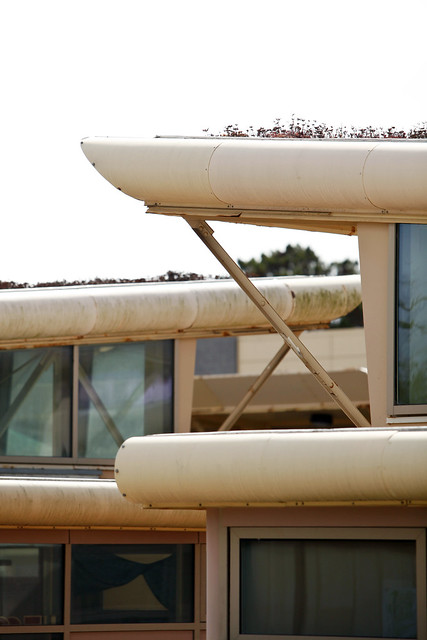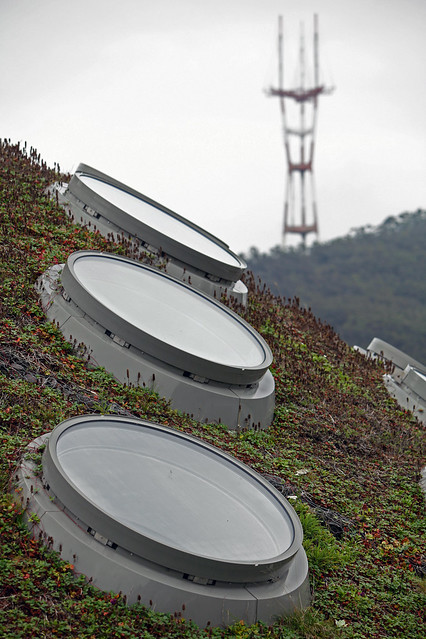They sit silent on rooftops and cling quietly to walls. They sneak into small corners of concrete and spread out over thousands of square feet. They’re here, and they mean to stay.
From above, these patches of green and bright colors that dot the cityscape are helping turn San Francisco into a blissful Eden. Here and elsewhere, cities are transforming themselves into havens for green ‘living roofs’ – rooftop gardens and other projects that provide new and creative spaces for plants to flourish in the urban landscape.
Not only can plants be snuck into unusual spaces around a city to attract the eye, but they also contribute to improvements in air quality and balancing the local ecology by attracting certain insects and contributing to pollination. “Living architecture…in San Francisco’s neighborhoods creates a better quality of life for everyone,” says Mike Kerwin, co-founder of Lorax Development in the city that creates green roofs on residential buildings. “Not only do living roofs encourage wildlife diversity, but buildings become more energy efficient and they manage storm water runoff, which benefits the building, the residents, and the surrounding environment.”
Though not easily seen from street level, the Osher Living Roof at the California Academy of Sciences is one such achievement. The Academy’s roof is the largest living roof on a natural history museum in the world, hosting 1.7 million plants native to California. The roof keeps the temperature of the building consistent by reducing roof heat loss and contributes to the surrounding ecology by collecting rainwater to prevent roof runoff. Its purpose is educational, as well as practical and sustainable. The native plants that have been installed – Strawberry, Self Heal, Sea Pink, and Stonecrop – were selected for their year-round vitality and attractive blossoms to lure curious observers and honor Northern California species.
But the roof isn’t all flat, and the slopes of the bio domes that sit atop the roof of the Academy pose a design challenge. How to get the dirt to stay put? An ecological design firm created BioTrays for the roof, biodegradable trays made of coconut fiber to house the plants. Fifty thousand of them cover the roof, and since they’re porous, roots grow through the trays and interlock to create one large mass, according to Academy Senior Botanist Frank Almeda. Solutions like these propel the ecological design field by removing the limitations of roofs and sloped surfaces.
Bay Localize is a local nonprofit project that works to support the green economy with community projects like roof greening. They explain that living roofs can double the life of a roof by offering protection from temperature changes, ultraviolet radiation, and other damage, and only need to be inspected a couple of times a year.
City College of San Francisco installed a green roof on their Joint-Use Facilities Building at their Ocean campus as part of the building’s complete sustainable design, which includes solar panels and a geothermal-powered heating and cooling system. “We wanted to design a building that was sustainable,” says Marian Lam, head of Facilities Planning and Construction at CCSF. “We wanted to utilize the current features that we would be able to use in a building, and we wanted to achieve the LEED certification.” LEED, Leadership in Energy and Environmental Design, is a certification system for green building developed by the U.S. Green Building Council.
Richard Parker is a founding member of 450 Architects, a certified green business, and also a member of the SPUR Sustainable Development Committee in San Francisco. He works to facilitate the installation of living roofs within the city and county, and has proposed a project for a community building in the Fillmore District with a rooftop garden that feeds a restaurant beneath. “For me, a green roof is one component of sustainability,” says Parker. “I think the roofs are a wholly unutilized space. The city’s kind of awesome from the roof level. The concept was that the community space would have this beautiful greenhouse with a glass floor, an architectural jewel celebrating the creation and serving of food in the same building.”
By greening rooftops for garden systems, energy efficiency, ecological balance, and by installing living plants wherever blank space is available in our habitats, we are getting back to nature. Rather than simply decorating spaces with plants and flowers, new sustainability ideas like roof greening are bringing humans back into harmony with the natural world and giving living things new spaces to thrive.





Jenny Jenkins • Dec 29, 2020 at 12:04 pm
Thank you for this post. I found it helpful. I will check back later for more great content. I also found some good information here https://conservationconstructionofdallas.com/leaf-blaster-pro/ Anyway, keep up the good work and I’ll check back later to read more amazing material.
Doug Oliver • Apr 1, 2013 at 9:14 pm
Green roofs are such a great way to utilize an otherwise waste of space. Articles such as yours are a great way to bring about the much needed awareness and benefits of these types of roofing systems. Thanks for sharing this!
Linda Kemmerley • Dec 4, 2011 at 5:11 pm
Wonderful piece…very informative …very well writen!